Notes from James Street South Jane's Walk
Some people asked for my notes from this past Saturday's Jane's Walk along James Street South. I added some photos for those who would like to follow the tour from Gore Park to Ballinachinch.
By Ryan McGreal
Published May 05, 2014
Cities need old buildings so badly it is probably impossible for vigorous streets and districts to grow without them. ... Old ideas can sometimes use new buildings. New ideas must use old buildings.
— Jane Jacobs, The Death and Life of Great American Cities
I was honoured (and rather terrified) to be asked to lead a Jane's Walk in Hamilton last Saturday. My walk focused on James Street South and started on Saturday, noon, at the Gore Park Queen Victoria statue.
I was told the walk should take an hour or so, but I had no idea how many people would show up or how long it would take to walk it, so I decided to err on the side of having too much information rather than too little.
The walk had an amazing turnout and there was indeed more than an hour's worth, but we collectively decided to call it a day at around the 1.5 hour mark (we had reached St. Joseph's Hospital) as the rain that had been falling since just after the start of the tour seriously intensified.
As promised, here are my notes from the walk, including the stops past Charlton which we didn't get to see. I took some photos at lunchtime today so anyone walking the route can follow along more easily.
Three Tales of a Street
- Amid all the observations, anecdotes and asides
- Three distinct stories about James Street South:
- Successive waves of development
- 1850s - stone, row houses, Gothic/Italianate churches
- 1880s - brick, Victorian/Second Empire/Queen Anne
- 1920s - Art Deco, Moderne, industrial, streamlined
- 1950s - Car-oriented
- 1970s - Tower-in-a-park, surface parking
- Durand vs Corktown
- Durand
- Affluent neighbourhood
- Started in 1791
- Land owned by wealthy speculators like George Hamilton
- James Durand never owned any property in Durand
- Affluent residents organized to protect heritage
- Important heritage victories
- Corktown
- Named after Irish City of Cork
- Working class immigrants
- More heritage destroyed
- More blocks demolished
- Remaking street for cars, not people
- Converted to one-way 1950s
- Off-street parking
- Demolition for surface parking
- 19th to mid-20 century optimism, followed by belief that new development will be worse than old
Victorian Era
- Drastic changes in technology, economy, culture
- Major changes in civic infrastructure: water and sewer, telegraphy, telephony, electricity, bicycles, streetcars, buses, automobiles
- Municipal role expanded significantly
- Victorian era gave us humanitarian nonprofits, e.g. YMCA, SPCA, CAS, VON
- James Street South is very much a Victorian street
- Hamilton is very much a Victorian city
Gore Park
- Most cities have a civic square, we have a civic triangle
- George Hamilton owned a wedge of land downtown and Nathaniel Hughson owned the other wedge, which together would have made a Town Square.
- Hamilton donated his part but Hughson reneged. That's why Hamilton got a whole town named after him and Hughson just got a street. :)
- Instead of a park, nearby merchants used it as a parking area and open dump.
- "The Gore on King Street"
- First called a "park" in 1860 during beautification
- Comprehensive and often hilarious history on on hpl.ca
- The City's tendency to abuse Gore Park, chop down its trees, restrict public access and use it as a dumping ground goes back nearly 200 years.
- Pedestrianization Plan launched in 2007
- Gore Summer Promenade - people enjoy a park when it is enjoyable
- Current plan to raise street to top of curb b/w Hughson and John
- Shuttered buildings behind hoardings don't help!
Queen Victoria statue
- Casts a long shadow over James Street
- "Model wife and mother"
- Coronated June 28, 1838 and died Jan 22, 1901 - reigned 63 years
- Statue first proposed in 1860
- Serious plan introduced Jan 26, 1901 by a group of Hamilton women
- Designed in 1906 by Louis-Philippe Hebert of Montreal
- Estimated cost: $10,000
- Cornerstone contains:
- City and telephone directories of 1901 and 1907
- Copies of the Times, Spectator and Herald
- Herald owner Billy Carroll started Around the Bay Road Race in 1894
- Copies of city by-laws and financial statements
- Coins and stamps
- Union Jack and Canadian Flag
- List of city council, school board and advisory members
- Bible
- Statue unveiled in 1908
- 22,000 people attended unveiling
- Presided by Governor General Albert Henry George Grey, Earl Grey (of Grey Cup fame)
- 1958: cleaned of grime and treated to reduce corrosion
- 1988: cleaned again to remove green oxidization, and had another unveiling, this time with Governor General Jeanne Sauve
- Lion's tail broke off in 1967, restored later in 1988
- 1996: cleaned again to remove pigeon guano
Gore Park Fountain
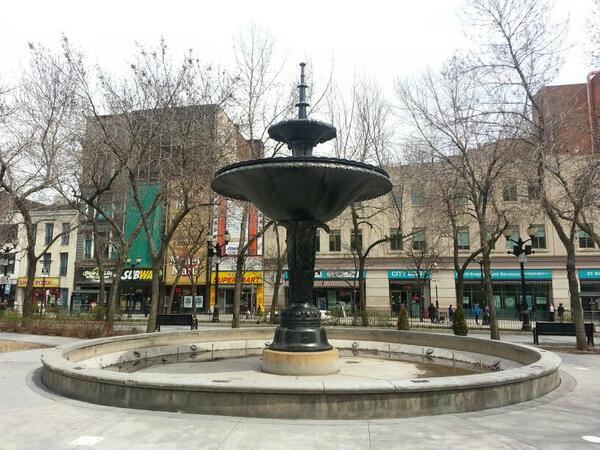
Gore Park Fountain
- Built in 1860 to celebrate the city's first water system
- Dismantled in 1959
- Kinsmen financed a new statue for $10,000, opened in 1960
- Widely criticized for looking strange ("flying saucers") not working well
- Another replacement built in 1970
- 1990s, Head-of-the-Lake Historical Society called for recreation of original fountain
- Recreated original fountain installed in 1996 for Hamilton's sesquicentennial 150th anniversary
18-28 King St E
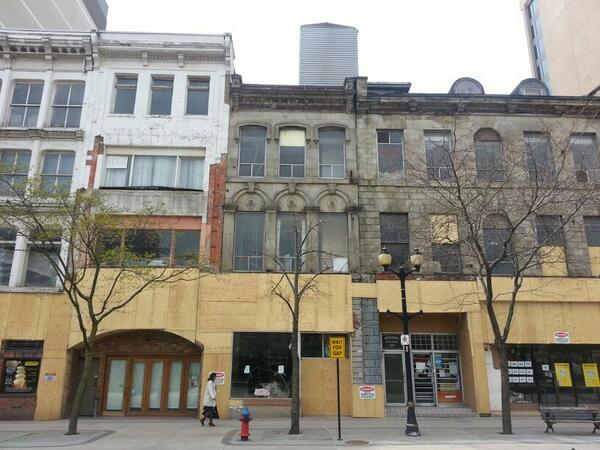
18-28 King St E
- #18-22, "Kerr Buildings" wholesale dry goods store, later ready-to-wear clothier
- Designed in 1840 by William Thomas, one of the most celebrated architects of the 19th century
- Thomas also designed:
- St. Paul's Presbyterian (we'll see soon)
- "Ballinahinch" mansion James and Aberdeen (we'll see soon)
- "Arkledun" mansion John St S at escarpment
- "Inglewood" mansion for Archibald Kerr on Inglewood Ave
- Bank of British North America on King Street (demolished in 1953, replaced with Scotiabank)
- Orphan Asylum and Aged Women's Home on Wellington (demolished 1959)
- "Undermount", a villa for John Young on John Street South (demolished 1966)
- #24, built 1876-6 for crockery merchant James Skinner
- #28, built 1874 for furriers William H Glassco & Sons
- $24-28 are good representative Victorian buildings
- #30 demolished in May 2011 as a kind of 'trial run'
- Supposed to be an outdoor cafe patio, but that never happened
- December 2012, Blanchard applied for a demolition permit for 18-28
- Vague proposal to build some kind of new development on most of the block
- $120M but no detailed plan, no funding, property owners arguing during press conference
- Wants a large-footprint retail use so only have to collect 1 rent cheque
- Blanchard's own market research shows there's a stronger market for small-scale urban retail
- Big-footprint new build only good for major chains
- Buildings not designated under Ontario Heritage Act
- Council didn't want to designate them b/c afraid it would deter investment
- Owner stripped off facades
- City spent months trying to work with property owner
- City offered $1M heritage grant, developer said they need $2M
- Same company demolished 20 Jackson St W
- Property tax went from $77K a year to $7K - council was mad
- Designated 18-28 last December
- Issued property standards order to comply with exposed facades
- Darn buildings refuse to fall down!
Commerce Place I and II (CIBC buildings)
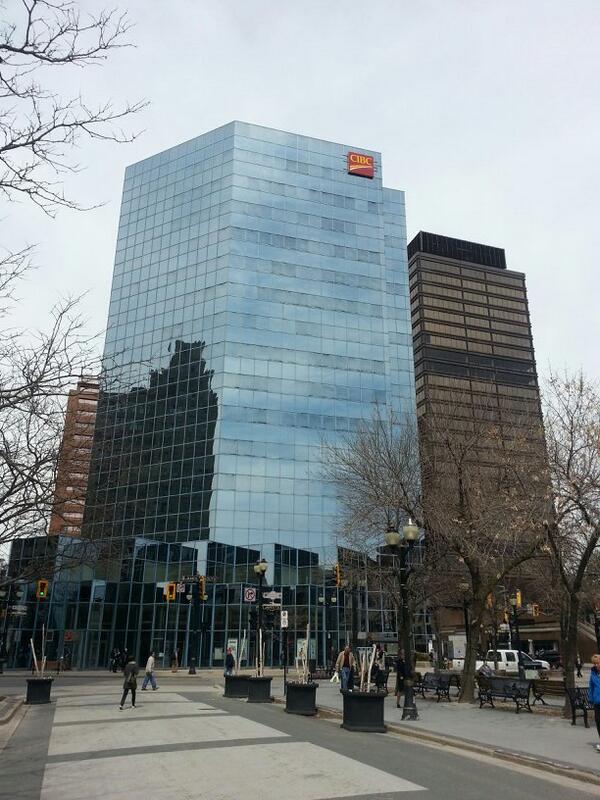
Commerce Place I
- Octagonal steel and glass towers
- Built in 1987 (east) and 1990 (west)
- Almost 400,000 square feet of Class "A" office space
- Cost $30M to build both towers
- Head office of the Bank of Hamilton in 1872
- Bank of Hamilton opened 128 branches across western Ontario and western Canada
- Merged with Bank of Commerce in 1924
- Owned for a while by Fercan Developments
- same company that owned former Molson Brewery in barrie with $30M grow op
- also owned Hamilton City Centre (former Eaton Centre)
- City Centre built for $70M in 1990, Fercan bought it for $3.6M in 2000
- Sold to Barrie developer in 2011 for $25M
- Traded this past February to Partners Real Estate in property swap
- Bought by Effort Trust in 2005 for $21.6M
- Sold in 2009, managed by Wilson Blanchard
- Renovated in 2011
- Vacancy dropped from over 35% 5 years ago to single digits today
Vacant Lots, west side of James
- Lots between Commerce Place and Pigott
- 18-24 James St S - Robinson's (demolished 1990s, now a parking lot)
- 28-32 James St S - Royal Bank (demolished after 1999 - not a parking lot)
Scarfone Hawkins Building
- Canada Life Assurance Building designed by Richard Waite (Ontario Legislature), built in 1883
- Oscar Wilde called it the most beautiful building in North America
- Severely damaged in a fire in 1929
- Henry Birks and Sons restored it in 1930, adding copper roof and Birks Clock
- Clock designed after "The Clock of the Charging Horsemen" for Wells Cathedral in Somerset, England
- Demolished in 1972 to make room for an office tower
- Birks moved to a new store in Jackson Square
- Clock attached to the Scarfone Hawkins building in 1974
- Later moved to Jackson Square at King and James
- Now restored and hanging inside the Farmers' Market
Canada Permanent Building

Site of Canada Permanent building
- Between Scarfone Hawkins and Landed Bank
- Built in 1961, demolished in 1999 and turned into a parking lot
- Council passed so-called "Blanchard Bylaw" - can't demolish a downtown building and turn it into parking
Pigott/Sunlife building
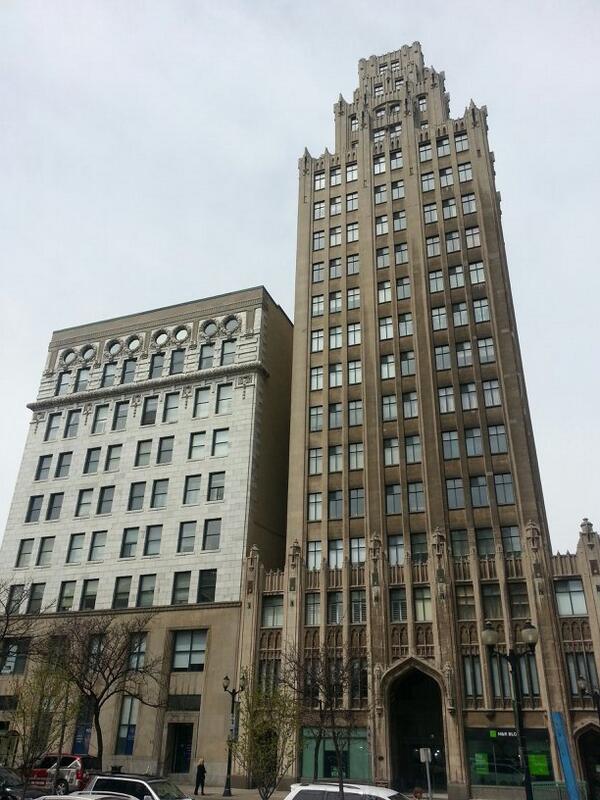
Pigott/Sunlife building
- Built in 1929 for $1M
- Hamilton's first steel-frame skyscraper
- Tallest building in the British Empire (race on at the time)
- 18 floors, 64m (210 ft) tall
- Art Deco and Gothic Revival elements
- Fell into disrepair in the 1970s
- Windows, door handles etc. were removed and sold off
- Willie Thompson was the last tenant, living in a basement apartment
- Designated as historically significant in 1984
- A Mr. Pupolin bought it in 1986 and started renovating it
- Sold mid-construction to Toronto Development Company
- Stained glass windows were found in an antique shop and bought for $12,000, reinstalled in lobby
- Stained glass windows depict:
- Pigott under construction
- Carpenter
- Mason
- Engineer - J. M. Pigott (I have this on good authority)
- Combined with Sun Life building for a 109 unit condo
- 92/109 units were sold within 8 months
Landed Banking and Loan
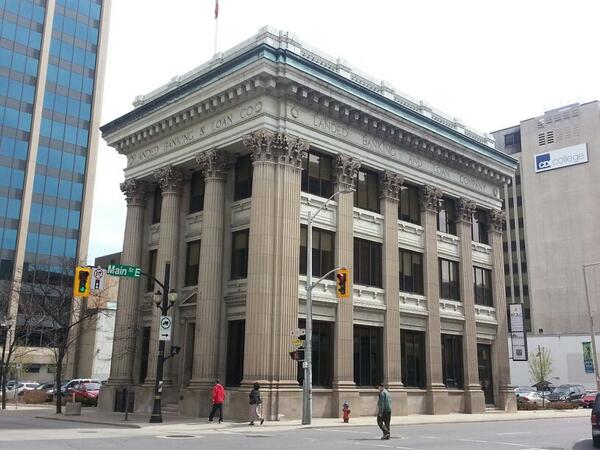
Landed Banking and Loan building
- Built 1908
- Designed by local architect Charles Mills
- Inspired by Knickerbocker Trust and Safe Deposit Bank in NYC (now gone)
- Oldest remaining bank building in Hamilton
- Heritage Designation in 1986
Main Street
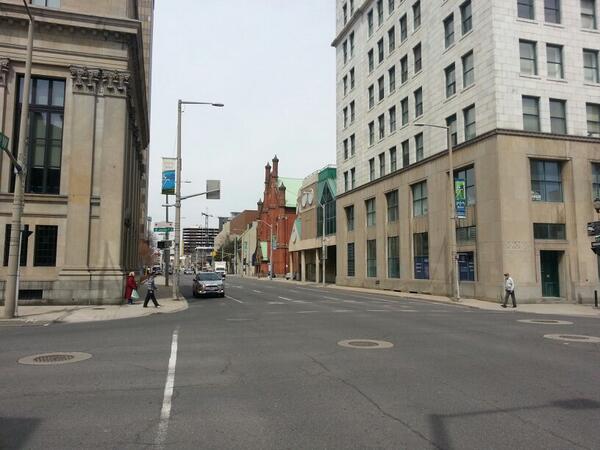
Main Street at James
- 5 lanes of one-way traffic
- One of the biggest obstacles to urban revitalization
- We have to choose: streets for cars or streets for people?
- Cities that choose people have thriving downtowns
Bank of Montreal
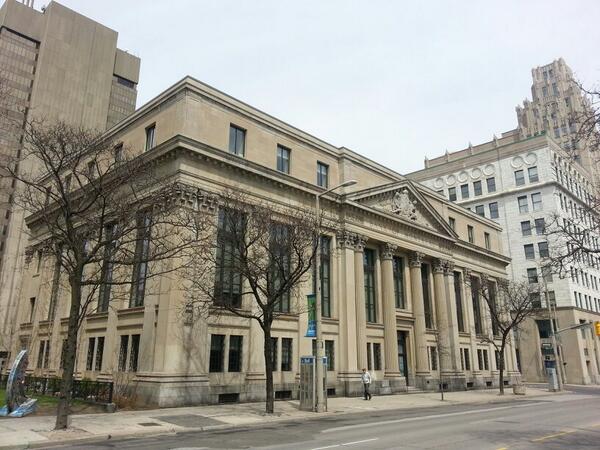
Gowlings/Bank of Montreal building
- Designed by Kenneth G Rea, built in 1928 by Pigott Construction
- Designated under the Ontario Heritage Act
- Made into a dance club in the 1990s
- Now Gowlings LLP
St. Paul's Church - Doors Open site
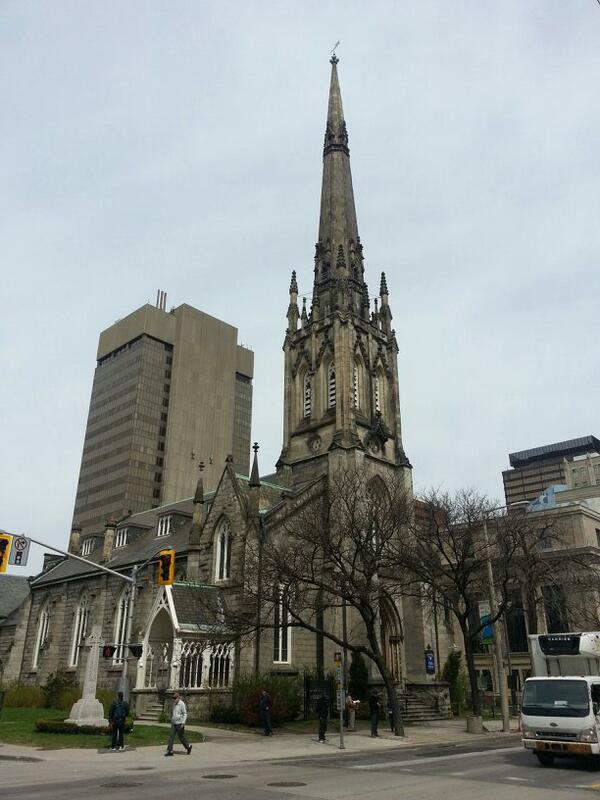
St. Paul's Church
- Designed by William Thomas, built 1857
- First-rate mid-19th century Gothic style
- 55 m (180 ft) spire the only one of its kind in Ontario
- Originally called St. Andrew's
- Changed to St. Paul's in 1873
- Original bell was the first Hamilton town bell
- Replaced with 11 bells, installed in November 1906
- Bells weigh between 136 kg (300 lbs) and 955 kg (2,100 lbs)
- Celtic Cross of Sacrifice (SE corner) carved in Scotland
- Cross installed 1921 to commemorate congregants who had died in battle
Whitehern - Doors Open site
- Rare surviving walled garden estate
- Home of Calvin McQuesten
- Physician and pharmacist in upstate New York
- Moved to Hamilton in 1830s
- Established a foundry - factory that makes metal castings
- Foundry was at James and Merrick, where City Centre now stands
- Bought "Willowbank" in 1852, renamed it Whitehern
- Son Isaac took over from Calvin and lost the family fortune - bad investments, drinking
- Grandon Thomas Baker was councillor, Public Works Chair, MPP, Public Works Minister
- T.B. McQuestin High Level Bridge named after him
- McQuestins lived in Whitehern until 1968, then willed it to City
- Became National Historic Site of Canada in 1962
- Restored in 1971 and made into a historic house museum
Bell Telephone Exchange
- Art Deco style, built 1929
- Named Baker Exchange after Hugh Cossart Baker, Jr
- First exchange in British Empire (second in North America)
- Original exchange building still stands: LIUNA 837 office at 44 Hughson St S
James Street Baptist Church
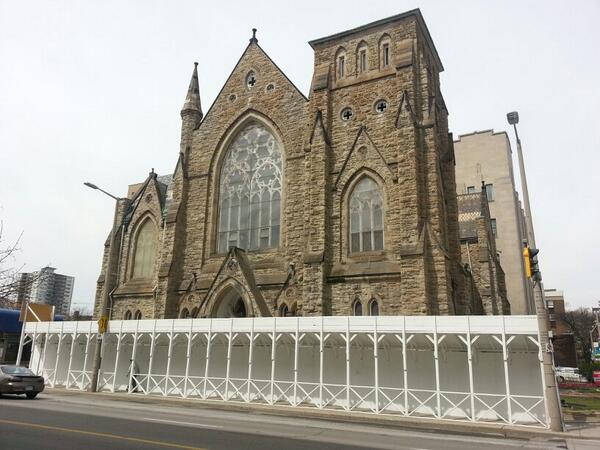
James Street Baptist Church
- Designed in 1878 by Joseph Connolly, a Catholic architect, and built in 1882
- Connolly also designed St. Patrick's Church at King and Victoria
- Designed in the classic Gothic style
- Meant to compete in appearance with St. Paul's
- Adapted from design of Church of Our Lady in Guelph (also by Thomas)
- Polished pink granite pillars
- Designed with prominent transept with nave and aisles
- Baptist churches usually amphitheatre with seating in a radius around pulpit
- Played a role in moving Toronto's Baptist College to Hamilton - now McMaster University
- Was Hamilton's oldest surviving Baptist Church until it was sold
- Designated under the Heritage Act
- Bought by Stanton Renaissance, Toronto developer run by Louie Santaguida
- Owner says foundation is structurally unsound and can't be saved
- Pipe organ was removed:
- 20,000 lbs, 2,000 pipes
- Dismantled and taken by Northern Organs
- They must donate it to another church and charge only for their labour
- Technically not a demolition but a "building alteration"
- 80% of building will be altered out of existence
- East facade will be saved, owner will try to save some other features
- No redevelopment plan or details yet
YMCA Downtown Hamilton
- Yes, it's an ugly building - but people in the 1970s thought Victorian buildings were ugly
- Company at 81 James St S in 1884 made wooden boxes for the original Bell telephones
TH&B Hunter Street GO Station - Doors Open site
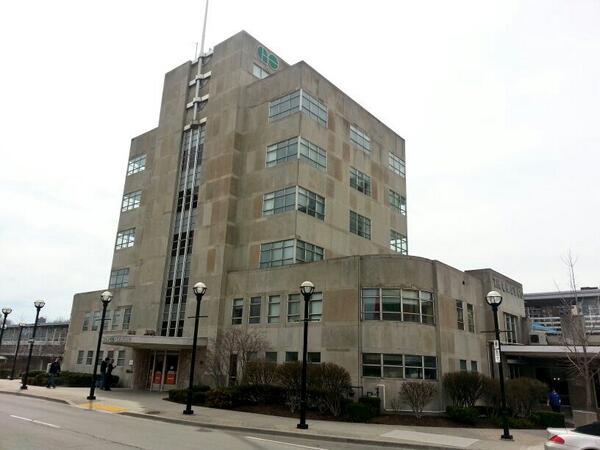
TH&B Station
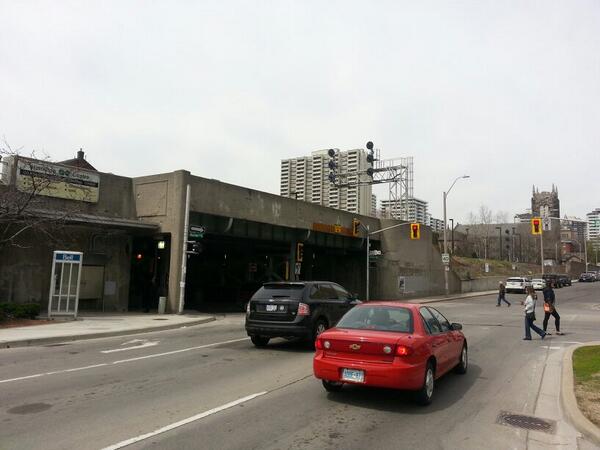
James Underpass
- Toronto, Hamilton and Buffalo line
- Linked Canadian Pacific with American lines
- Competed with Grand Trunk Railway (now CN)
- Operated from 1895 to 1990
- Started out as passenger rail, later moved to freight
- Tracks used to be at street level
- James, John moved to underpass in 1930s, Hughson made discontinuous
- Line ran under Hunter Street through Durand - affluent
- Line ran at grade with a rail yard through Corktown - working class
- Original station on NE corner of James and Hunter
- Streamlined Moderne station and headquarters built 1931-3
- TH&B bought by CP in 1987, closed in 1990
- Building restored, GO Station opened in 1996
MacNab Church - Doors Open site
- Unknown who designed it, built 1857
- Cornerstone laid by Isaac Buchanan, who built Auchmar
- Fantastic acoustics inside
Mural
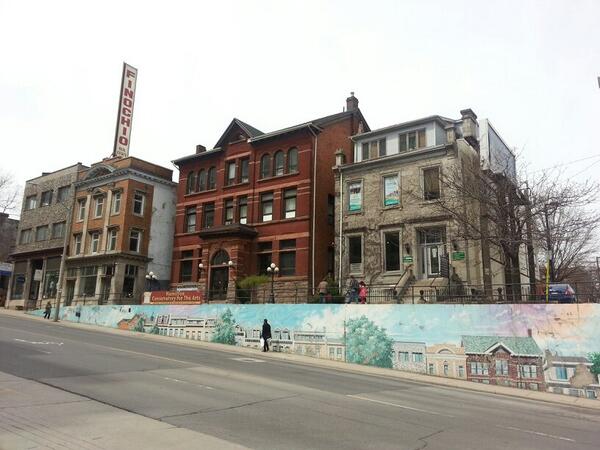
James South Mural
- Painted by artist Graham Muir
- Organized by James Street South District Street Beautification Committee
- $6,000 cost funded by several local businesses
- Unveiled in November 2006
Hamilton Conservatory for the Arts
- Designed by A. W. Peene, built in 1905
- Originally Hamilton Conservatory of Music
- Closed in 1980
- HCA opened in 1998
- Heritage designated
James Street Bookseller
- Owner Monique Doepel moved here from Toronto's Queen West
- Started in basement under Dungeon Divas, who later needed the dungeon
- Was called James Street Book Cellar
- Changed one letter of name after moving
- Beautiful inside and out
Chateau Royale
- Converted from an office tower
- Upscale condo apartments/hotel opened in 2006
- 230 feet (70 m) tall
Two-Way
- James converted to one-way in 1950s
- Plan by Wilbur Smith and Associates traffic engineers
- Increase vehicle flow on Victorian street grid
- Paired one-way streets
- Great for automobile traffic flow
- Terrible for street life
- Downtown started to go into decline almost immediately
- Not the only cause but a major cause
- James/John North converted back to two-way in 2002
- Predictions of chaos and disaster never materialized
- James/John South converted back to two-way in 2005
- More predictions of chaos and disaster, also never materialized
- Steady incremental revitalization
- New restaurants and other businesses
- Still 2 lanes in each direction
- Needs curbside parking priced for turnover:
- Slows traffic
- Protects sidewalks
- Boosts business
- Meter revenue invested in sidewalk improvements
- Also needs more and better pedestrian crossings
- Intersections with no crosswalk
- Ped crossing buttons don't work
- No crossing allowed at some corners
Bold sidetour
- Peter Hamilton Terrace
- Fantastic mid-19th century Scottish Freemason stonework
- Check out Masonic Lodge at King and Queen
- Block originally subdivided by Peter Hamilton (George's son)
- Hereford House, now Turkstra Mazza Law
- Built 1862 - architect known only as "Balfour"
- Isaac McQueston bought it in 1875
- McQuestons sold it in 1969
- Pasadena Apartments #27
- Built 1914
- 13 apartments, 32 residents
- Heritage designated, beautiful
- One of the first apartment houses in Hamilton
- Destroyed in a fire earlier this year
- Fire started in boiler room
James South Stone Terrace #140-160
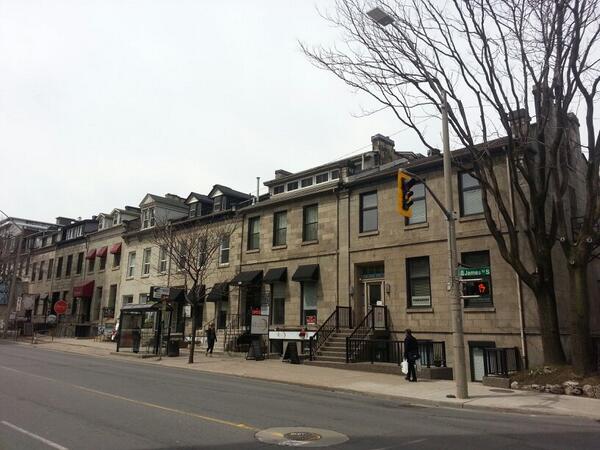
James South Stone Terrace
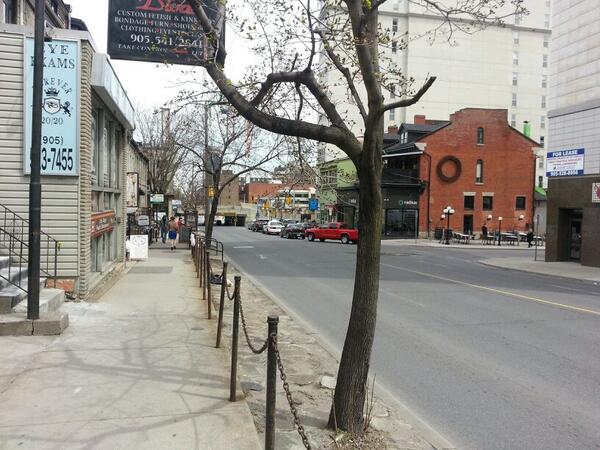
Two-tiered sidewalk
- Built in mid-18th century
- Coffee House easily overlooked
- Great spot, tiny outdoor seating
- Recently changed name, maybe owners
- Bistro Parisien a great French restaurant
- Saigon Soul Food makes awesome spring rolls
- 2 erotica shops: Dungeon Divas and Spoterotica
- Boo's Bistro another great fusion restaurant
- Chef Vibulan "Boo" Aria from Malaysia
- Weird two-level sidewalk with fencing makes street less walkable
- Healthy urban places encourage jaywalking
- James South torn between roles as CBD and commuter thoroughfare
Radius
- Don't forget about Steve's Open Kitchen - great all-day breakfast
- Named for commitment to local food
- Cafe on left, restaurant on right
- Outdoor patio on Augusta
- Rooftop patio overlooking James
- In restaurant, sit at window facing outward
- Really good duck grilled cheese sandwich
- Owned by Paven Bratch
- Some food comes from family-owned Tally Ho Farm in Carlisle
- Father, Yogi, owned IDA pharmacy on south corner
- Isaac Buchanan used to live there after Auchmar
- Building for sale as of February, listed at $2.9M
Augusta sidetour
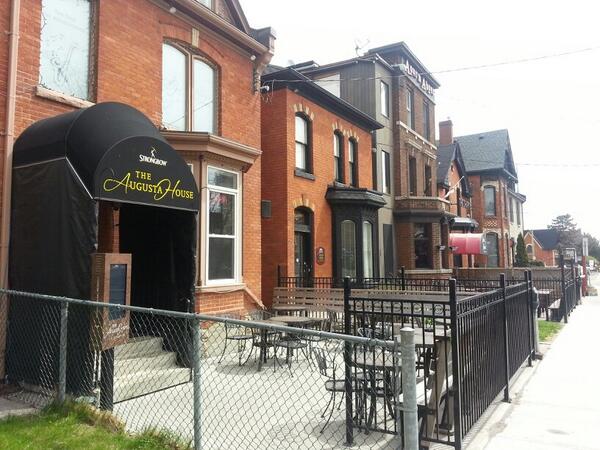
Augusta House

Surface parking
- Lots of surface parking from demolished buildings
- Do we want to encourage people to drive to the bar to drink?
- Corktown got hit harder than Durand
- Pubs on Augusta
- #17 Augusta House
- built 1895, heritage designated
- stained glass transom windows
- #20 Pheasant Plucker
- Great stone house
- Surrounded by parking now
- St. Charles Garnier Catholic church
- Built 1961, modernist Catholic architecture
- Amphitheatre design, not like Gothic churches
Duke sidetour
- One Duke stone building
- Amisfield Mansion
- Jacobean Revival mansion built in 1840
- Almost demolished in 1950s
- Plaza built in front of the mansion
- Sandyford Place, Duke and MacNab
- Built 1858
- Designed after Scottish stone terraces with elaborate stonework
- Nearly demolished in the 1970s for an apartment tower
- Designated a heritage site in 1975
- Restored in 1982
- Early victory of the Durand Neighbourhood Association
Strip Mall between Duke and Robinson

Amisfield hidden behind strip plaza
- Early example of car-oriented development
- Never expect people to walk up a flight of stairs today
- Built in front of Amisfield
- La Piazza Allegra great Italian, nice braised rabbit
- Button Crosswalk at James and Young - takes a long time to activate on weekdays
Medical Arts Building
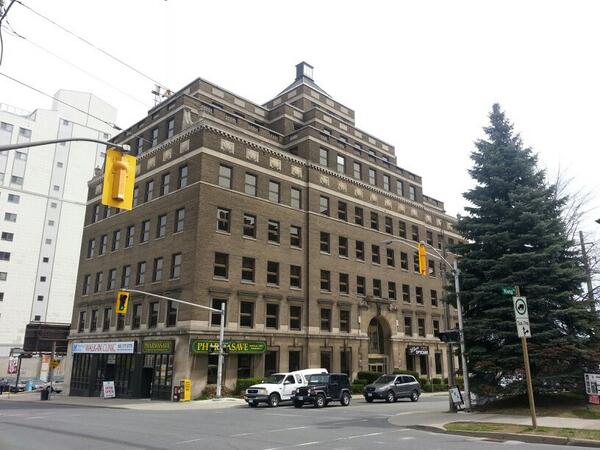
Medical Arts building
- 8-storey, built in 1930s
- Note the demolished surface parking lots around it
Forest sidetour

Frederick James Rastrick House
- Wass Ethiopian - yum
- #46 Frederick James Rastrick House
- Thank goodness for lawyers saving old buildings!
- Frederick James Rastrick was an ironworks engineer
- Became an architect, studied under Charles Barry in London
- Moved to Hamilton in 1853
- Designed this as his residence
- Italianate palazzo style
- ALso Designed Young, Law & Co warehouse (Coppley Apparel on York) in 1854
- Might have designed Sandyford Place
- 2 of his sons became architects, office in old Lister building (pre-1923 fire)
- Applied for job of architect for Dept of Public Works
- Make note of Church of the Ascension
- #64 Forest at John
- Gothic Revival style
- Designed by Frederick Cumberland and Thomas Ridout
- Built 1850-51
- Frederick Rastrick designed Sunday School in 1872
St. Joseph's Hospital
- Sisters of St. Joseph started in Hamilton in 1854
- Founded St. Joseph's Hospital in 1980
- 25-bed hospital on John Street
- Nursing school opened 1911
- Medical School with McMaster in 1969
- Firestone Institute for Respiratory Health
- Father Sean O'Sullivan Research Centre
- Established 1993
- Chest & lung, drug therapy, urology, nephrology, musculoskeletal research
- Fr O'Sullivan born in Hamilton in 1952
- Worked for Ellen Fairclough in 1963 (she lost)
- Fairclough was first female member of Canadian Cabinet
- Secretary of State, Minister of Citizenship and Immigration, Postmaster General
- Has an ugly building on King Street West named after her
- O'Sullivan was PM John Diefenbaker's executive assistant 1971
- Elected MP for Hamilton-Wentworth in 1972 at age 20
- Re-elected in 1974
- Left politics in 1977 and joined the priesthood
- Personal sidenote: he was my parish priest in Ajax
- Found out he had leukemia in 1983, died in 1989
- Juravinski Innovation Tower
- Annual budget of $500 million
- Two-way James and John
- Amid the predictions of doom, ambulances would be gridlocked
- Turned out to be a wash
- Slightly slower during rush hour, but can approach either direction
Charlton and Beyond
- No pedestrian crossing at Charlton on south side
- Victorian houses just the right size for a boutique law firm
- Lintack Architects
- New commercial building at James North and Vine
- Condos at 61 Robinson
- 25 Hughson St S next to courthouse
- Ferguson Station parkette
- Annex renovation at 11 Rebecca
- Hamilton Energy Centre next to Sir John A MacDonald High School
#224 Lawry House (James and Charlton)
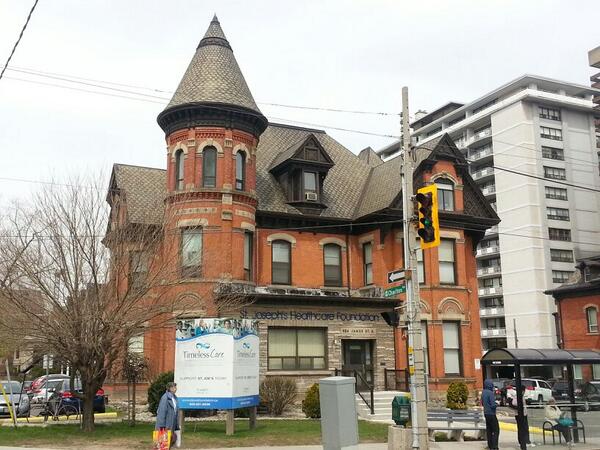
224 James St S
- Built 1904 for businessman Thomas Lawry
- Note the tower
#15 Herkimer
- mid-19th century stone terrace
- No pedestrian crossing at Herkimer on south side
#250 James - Balfour House
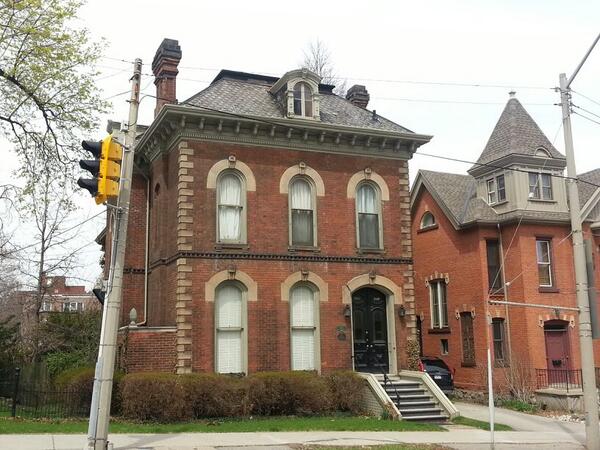
250 James St S
- Second Empire style
- slate mansard roof, arched windows and doors
- but with brick, not limestone
- Built 1880 for Hamilton Real Estate Association
- Design by James Balfour (built 1889 City Hall)
#252 - Griffiths palatial home
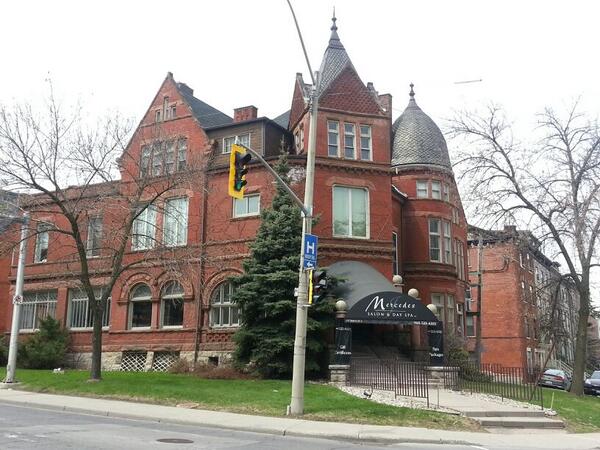
252 James St S
- Late Victorian style
- Designed by W. A. Edwards, buit 1891
- Built for Tunis B. Griffith, manager of HSR
- Later owned by Lt. Governor John S. Hendrie
- Converted to apartments in 1940s (?)
#262 - Coburn Queen Anne Revival home
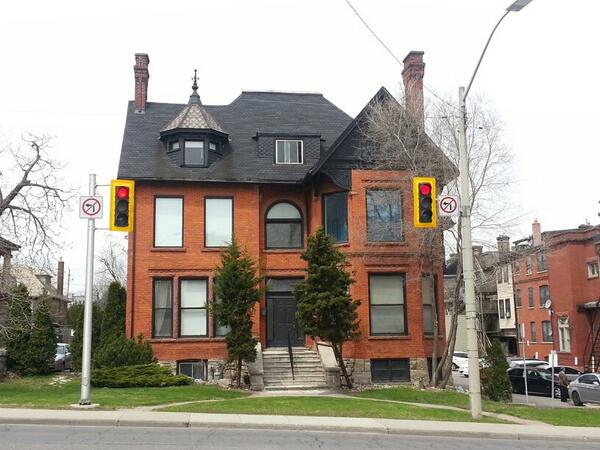
262 James St S
- Built 1892-3
- Restrained Queen Anne style - gables, octagon bay, hipped roof
- Converted to apartments in 1941
#268 - James Counsell home

268 James St S
- Designed by James Balfour, built in 1894-5
- Queen Anne style
- Built for investor James Counsell
Escarpment Stairs

James Street Escarpment Stairs
- Stairs there since at least 1860
- Original stairs replaced in 1987
- 227 steps
- Comes out at Southam Park at the top of the Claremont Access
- Other stairs:
- Chedoke Stairs, 289 steps, golf course parking lot to Scenic and Upper Paradise
- Dundurn Stairs, 325 steps, top of Dundurn to Garth at Beckett
- Wentworth Stairs, 498 steps, Wentworth and Charlton to Upper Wentworth
- Kenilworth Stairs, 229 steps, Kimberly Dr to Mountain Brow Blvd, crosses Escarpment Trail
- Unofficial: Uli's Stairs, 305 steps, Greenhill to Fennell and Mtn Brow
- Stairs at John and Ferguson no longer exist, removed when Jolley Cut was built
#316 Ballinahinch

316 James St S
- Designed by William Thomas, built in 1849-50
- Combined Gothic and Italianate styles
- Called "The Wilderness"
- Damaged and rebuilt in 1953 after fire
- Named Ballinahinch in 1870 by Edward Martin after grandfather's estate in Ireland
- Later owned by publisher William Southam
- Converted into apartments in 1944
- Condos in 1980
Sources
- Hamilton Library Archives
- Collections Canada Archives
- Library and Archives Canada
- City of Hamilton
- Historical Hamilton .com
- Canada's Historic Places Register
- Hamilton Spectator
- CBC Hamilton
- Raise the Hammer
Ryan McGreal, the editor of Raise the Hammer, lives in Hamilton with his family and works as a programmer, writer and consultant. Ryan volunteers with Hamilton Light Rail, a citizen group dedicated to bringing light rail transit to Hamilton. Ryan wrote a city affairs column in Hamilton Magazine, and several of his articles have been published in the Hamilton Spectator. His articles have also been published in The Walrus, HuffPost and Behind the Numbers. He maintains a personal website, has been known to share passing thoughts on Twitter and Facebook, and posts the occasional cat photo on Instagram.
11 Comments
Read Comments
Post a Comment
You must be logged in to comment.


























